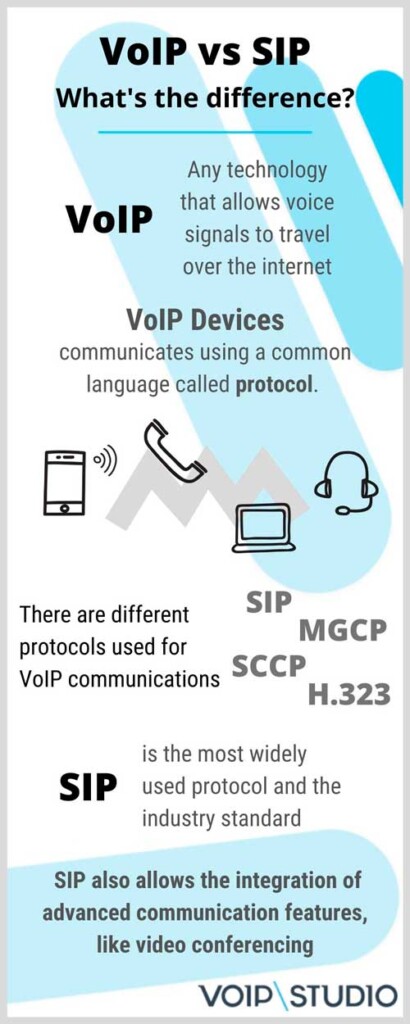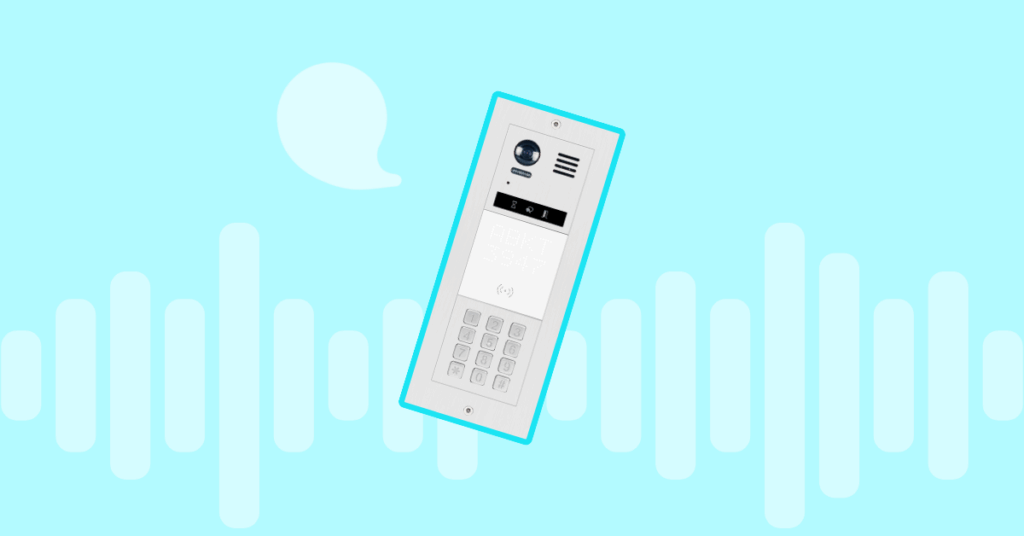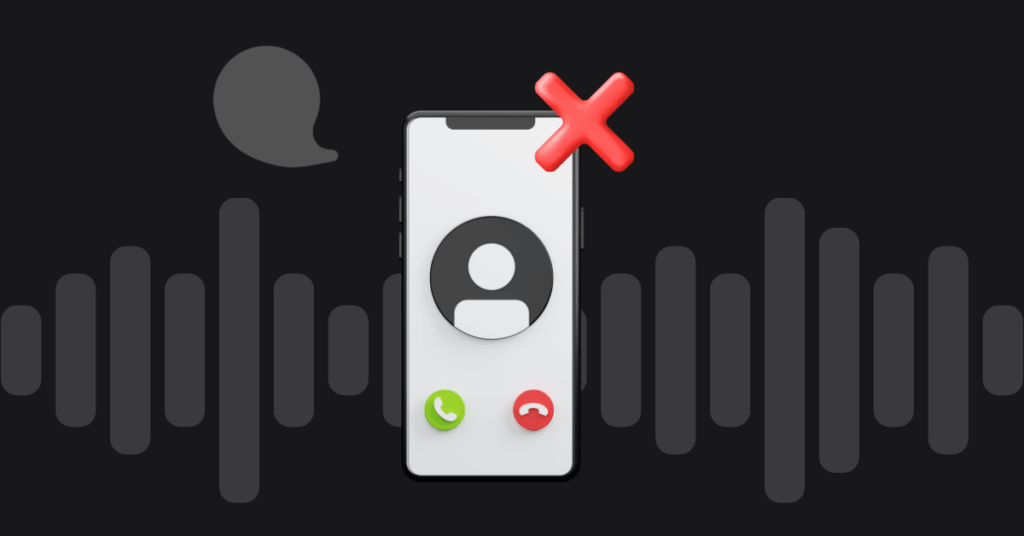
Table of contents
In the enterprise world, practically every technology comes with an avalanche of acronyms. Take telephony for instance. Not many people know what exactly PSTN, PRI, ISDN, VoIP, SIP, WebRTC, etc. mean. Sure, you may have a vague idea that it is used somewhere in the office. But few people have a better idea than that.
So, it’s not surprising that one of the most commonly asked questions is – what’s the difference between VoIP and SIP? To an industry expert, the difference is glaringly obvious. For an amateur, not so much. It often seems that vendors use them interchangeably, but they also refer to different things.
What’s the difference between SIP and VoIP?
In the world of telephony, VoIP and SIP are often used interchangeably by users but, technically speaking, they are not the same. Though they are related, they are not substitutes for one another. You cannot simply replace SIP with VoIP or vice versa.
SIP is one of the most popular ways of implementing or delivering VoIP services to consumers, households, enterprises and other entities. VoIP is a much broader term that can be applied to any form of voice calls that happens over the Internet.
When people ask about the difference between VoIP and SIP, they usually want to know which one to use. What is better for their company? Unfortunately, comparing VoIP and SIP is ineffective. That’s because they’re referring to completely different things.
Before you decide on a particular system for your business, take a few moments to understand the terms VoIP and SIP.
SIP definition
In the world of telecommunications and network engineering, a protocol is a set of rules that can be used by two entities to transmit data, information or signals. These rules define the syntax, method, standards and semantics of communication, to minimize confusion and make sure communication sessions can proceed efficiently.
The Session Initiation Protocol – which is abbreviated to SIP – is one such protocol that is used for signaling, setting up and controlling multimedia sessions. These sessions may involve audio, video, instant messages, 2 callers, multiple callers or any combination of the above variables. It is an IETF standard that was first introduced in the 90s and it continues to evolve today.
What the end-user considers a single phone call is actually divided into two phases – ‘call set up’ and ‘data transfer.’ SIP is used in the call set up phase and implemented in the application layer. SIP is used to initiate the call between two or multiple parties via SIP proxy servers. Once the initial parameters have been established, the actual call and voice data transfer happens directly between the endpoints in a peer to peer fashion.
SIP is simply one of many protocols that can be used to implement VoIP. It is used to set up and terminate multimedia sessions, including voice and video. At present, it is the most widely used protocol and is the industry standard. Perhaps when users are trying to figure out what VoIP is, the industry standard of using SIP with VoIP is why many people get confused between the two. SIP is almost ubiquitous in the industry.
Why is SIP important?
A protocol is a system of rules for exchanging messages between hardware. Modern digital services use many protocols such as SIP, TCP, HTTP, etc. A protocol defines the syntax and semantics of communication. For a protocol to be useful, different vendors must agree to use it on devices and applications. Over time, many protocols evolve to become industry standards as most developers start using it.
SIP is one such industry-standard used in VoIP. SIP dictates how messages are sent between endpoints to set up and manage multimedia sessions. The actual voice and video are carried by other protocols. SIP handles the management portion of calls. Most organizations opt for SIP as they can be sure of interoperability. You can buy SIP compatible hardware and know that it will work with your system. You don’t have to worry about compatibility and integration issues.
VoIP definition
VoIP stands for Voice over Internet Protocol. In short, it refers to any technology that allows voice signals to travel over the Internet. It can also be called broadband telephony, Internet telephony, and many other names. It doesn’t matter what technology you use or the hardware and software. Remember that if a voice call travels over the Internet, it can be called VoIP.
VoIP refers to any method of sending voice calls over the Internet. That means everything from Skype and FaceTime to enterprise phone services fall under the same umbrella. SIP is just one of the many protocols currently in use. So, you can implement VoIP with other protocols as well.
For example, Skype does not use SIP. But most enterprise-level phone systems rely on it. In other words, not every VoIP system will use SIP, but the vast majority of VoIP services do utilize it since it is the industry standard.
How does VoIP work with SIP?
Now that you know the specifics of what VoIP is and what SIP is, it’s time to understand how they relate to one another.
To visualize the relationship between SIP and VoIP, take the example of email. This is a universal service used by practically every person and organization today.
Email is commonly implemented through SMTP – Simple Mail Transfer Protocol. By implementing the services through universally accepted and standardized protocols, end users are able to send email without barriers. For instance, a Gmail user can send email to an Outlook user or a Yahoo user or an enterprise user in much the same way. It doesn’t matter if the person is using a standalone desktop client or a webmail dashboard.
This is pretty much how SIP and VoIP are related and work. When an organization utilizes SIP to deploy their VoIP network, it is easy for other entities to work with the same equipment. For instance, if the business purchases new SIP phones, they are already compatible with the network because they use the same protocol.
SIP functionality
SIP is extremely flexible and has powerful features that can be utilized in very complex PBX systems. It is a general-purpose protocol that can handle a variety of sessions. In VoIP specifically, SIP is used to perform a variety of functions including:
User registration
SIP endpoints – basically your telephones – register themselves with proxy servers that maintain lists of individual endpoint locations. When a particular phone initiates a call, the request is sent to the proxy server which then contacts the other endpoint to set up the session.
User availability
SIP determines if the various parties are available to answer the call or participate in the session. It means that different endpoints can set up rules stating when or how they would like to be contacted and when they are available for calls. For instance, a particular phone may not accept calls from 8 AM to 5 PM or will only accept calls from within the same network etc.
User capabilities
The various endpoints involved in a particular session use SIP to determine what kind of audio codecs and other media capabilities (video, file transfer etc.) can be utilized in the call.
Session set up
SIP tells the phone that is being called to start ‘ringing’ and manages the initial contact between all parties.
Session management
SIP also performs other management functions such as ending the call, adding another caller, switching to video conferencing etc.
VoIP only or VoIP with SIP?
There are several reasons why most organizations prefer to use VoIP with SIP. The first thing is that you can integrate different types of multimedia channels into a single system. You can transmit voice calls, video calls, conference calls, etc. It can integrate seamlessly with unified communication (UC) suites and CRMs. It is very flexible and provides failover options in case of emergencies.
- As an open standard, SIP allows you to connect huge range of compatible IP phones or Standard VoIP softphones. Other VoIP systems may require the use of their own branded devices. There is an amazing world of SIP compatible devices, hardphones, softphones, DECT phones, conference phones, gate o elevator intercoms, etc.
- SIP not only enables voice communication, but can also power your business with video conferencing and other unified communications (UC).
- SIP-enabled PBXs are often much easier to integrate with external platforms or CRM.
- SIP allows voice communication over the Internet, whereas some other standards may require the use of private networks that can be more complicated to set up. Therefore, the use of SIP can help to deploy telephone service in dispersed offices. This does not mean that other VoIP standards do not allow it, but you may have to do some complex configuration to enable it.
- The SIP community is much larger than any other VoIP communication standard. This helps ensure the reliability and usability of the standard and if you have any questions you are sure to be able to find them or share them easily online.
Sooner or later, organizations find that they have to upgrade to VoIP with SIP for advanced features. Keeping in mind future growth and expansion, it’s no wonder that the latter option is more popular.
Types of VoIP deployment
There are different types of VoIP deployment that one could use for their business. When choosing the right services for your communication needs, you should consider all types of deployment to ensure you make the best decision for you and your business. Some of the most popular VoIP deployments are as follows:
Hosted or Cloud VoIP service
When most people think of VoIP, they are imagining a hosted service. In this type of deployment, the vendor manages the PBX and all associated components. Phone services are delivered over the Internet to clients. Typically, customers are provided with a simple administration panel from which they can adjust the configuration of their PBX.
Hosted services are popular because they remove the hassle of maintenance and repair. You don’t have to manage the system, buy expensive hardware or update it periodically. It is quick and easy to get started with hosted VoIP services. Your provider will be responsible for maintaining, monitoring, securing and guaranteeing the availability of the service.
This type of deployment has its drawbacks. You have to rely on your provider to take care of their infrastructure. While the cloud service may be a bit more expensive, it avoids the need for in-house hardware and its maintenance. It can be cheaper in the end.
SIP Trunking
SIP trunking is a method of delivering phone services to enterprises with their own IP PBX. It replaces the standard PRI line between organizations and traditional phone carriers. It serves as a bridge between VoIP and the public phone network (PSTN). A SIP trunk is not a physical line but a virtual connection between your business and ITSP (Internet Telephony Service Provider).
The vendor is only responsible for the connection and providing a dial tone for you to use. You have to manage the PBX yourself. That means your team decides what features to enable and manage. You control when and how you upgrade your hardware and software. You are responsible for data security and privacy.
SIP trunking is more expensive to set up than hosted services. However, it can save a lot more money in large organizations with hundreds of users. Only in that case, SIP trunking gives a better return on investment than hosted services.
You can learn more about SIP trunking services in GoTrunk.com.
Hosted VoIP vs SIP trunking: which is better for you?
Most VoIP hosted services use SIP as the protocol of choice. So whichever type of deployment you choose, SIP will be a major component. Now we can ask the more relevant question rather than, what is VoIP? Should you go for hosted VoIP services or SIP trunking?
As with most technology-related questions, the answer is – it depends. It depends on a number of factors including:
Business needs
One of the primary differences between hosted services and SIP trunking is control. In the former option, you have very little control over features, customization, security, etc. With SIP trunking, you’re in charge of everything.
There are hundreds of VoIP services in the market today. So most businesses will be able to find a cloud VoIP vendor that meets their requirements. But if a hosted service cannot meet your business needs, then SIP trunking is the obvious choice.
Budget
While SIP trunking it is cheaper in the long-term, you do need the money to invest upfront. You have to purchase the IP PBX and other hardware components. For many small and medium businesses, the initial outlay may be well out of their reach.
On the other hand, you can easily get a VoIP number and start using hosted VoIP services for as little as $10 per month per user.
In-house expertise
With hosted services, you don’t need a team to manage the phone system. The vendor handles everything. A reputable provider will have multiple resources for troubleshooting and support as well.
With SIP trunks, you need to have a team that can deploy and maintain the phone system. If you already have a team in place, that’s great. If not, you might have to hire more people which can get expensive.
Long-term considerations
What is the growth potential for your business? How much change do you anticipate over the long-term? Hosted VoIP services can scale quickly. But if your business needs change dramatically, your current provider may not be able to meet them.
Expanding the user capacity of your PBX may require a larger investment. But for a large company, it makes sense to maintain control over telephone systems. The longer it is used, the lower the costs per user or per line.
SIP FAQs
Is SIP required for VoIP?
No. There are several protocols that facilitate voice communications over the internet (VoIP). SIP is simply the most widely used, but you can implement VoIP with other protocols as well.
What is a SIP account for VoIP?
A SIP account allows users to make voice calls over the Internet using VoIP technology. Think of it as the SIP version of your phone number: you have a unique ID that allows you to send and receive calls, as well as use the other services of your VoIP provider (such as call routing, video conferencing, etc.).
What is a SIP device?
As with SIP and VoIP, the terms “SIP phone” and “VoIP phone” are often mistakenly used interchangeably. Again, all SIP phones can be considered IP phones, but not the other way around. With an IP phone, you can make calls just like with the traditional network. However, SIP devices allow you to integrate advanced features, such as video conferencing.
If you work with an IP communications provider that offers advanced services over SIP, you will need a SIP device.
What does SIP Calling mean?
SIP calling is the process of transmitting voice calls over an Internet connection through various devices, such as computers and smartphones, using the SIP protocol.
Although the term “VoIP calling” is also often used, remember that there are other protocols, so not all VoIP calls are necessarily SIP calls.
Is SIP calling free?
Calls between SIP numbers or addresses are usually free of charge. However, since we usually want to use our SIP phone to call numbers on the traditional telephone network (e.g. calling from your SIP device to a mobile phone), these calls will have to be charged for, since they are using the traditional telephone infrastructure.
It is possible to find providers that offer limited free accounts or free VoIP trials, such as VoIPstudio.
Can you make SIP calls on iPhone and Android?
Smartphone users can make SIP calls using their Android phones or iPhone. You can set up an Android device to make and receive SIP calls using built-in SIP softphone, or by using a third-party app. In the case of iPhone, you will need to download an app to be able to make SIP phone calls.
What is the difference between SIP calling and WIFI calling?
Wi-Fi calling involves using a wireless Internet connection to make phone calls or send text messages instead of a mobile phone network. The most common and easiest way to make a Wi-Fi call is through VoIP technology, often enabled over the SIP protocol and nowadays powered up by WebRTC.
What is the difference between WebRTC and SIP?
WebRTC is not a protocol but a set of technologies. WebRTC enables real-time communications within the web browser. This allows calls to be established directly between browsers or from the browser to the traditional network. WebRTC does not replace the use of SIP. WebRTC provides a set of libraries to enable SIP communication over the https protocol.
Actually VoIPstudio uses WebRTC also in its computer softphone, Mobile App and Google Chrome Extension.
More from the blog
Want to improve your business communication?
Unlock enterprise-class call center power at affordable prices – no hardware, no delays, no surprises!







